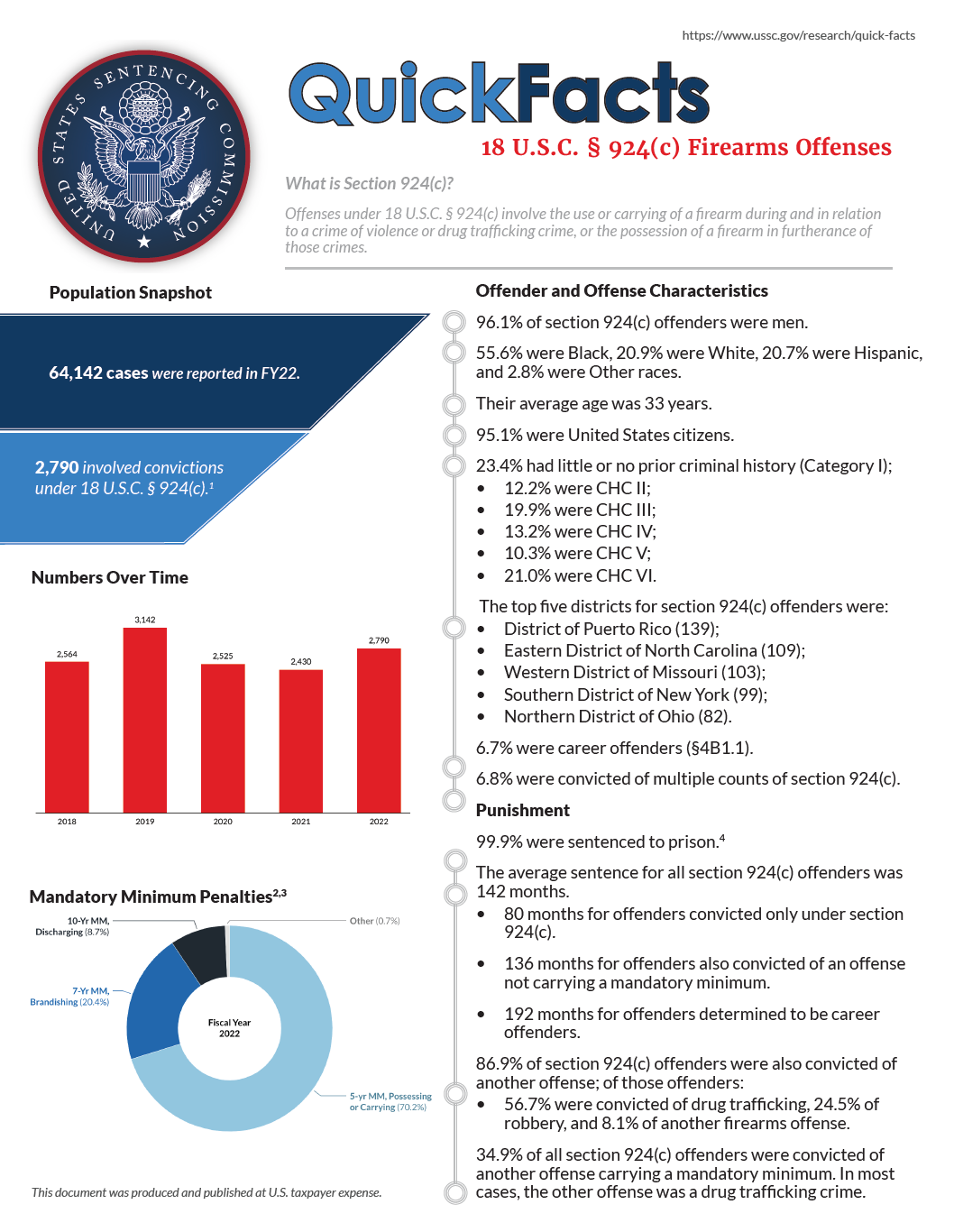Population Snapshot
Of the 61,678 cases reported in FY 2024, 2,522 involved convictions under 18 U.S.C. § 924(c).1 Offenses under 18 U.S.C. § 924(c) involve the use or carrying of a firearm during and in relation to a crime of violence or drug trafficking crime, or the possession of a firearm in furtherance of those crimes.
Click the cover for the PDF handout or learn more below.
Individual and Offense Characteristics
- 95.7% of section 924(c) individuals were men.
- 54.8% were Black, 22.9% were Hispanic, 17.8% were White, and 4.5% were Other races.
- Their average age was 34 years.
- 94.8% were United States citizens.
- 30.6% had little or no prior criminal history (Category I);
- 15.1% were CHC II;
- 17.7% were CHC III;
- 10.5% were CHC IV;
- 8.5% were CHC V;
- 17.6% were CHC VI.
- The top five districts for section 924(c) individuals were:
- District of Puerto Rico (135);
- Western District of Missouri (94);
- Southern District of New York (89);
- Eastern District of North Carolina (87);
- Eastern District of Missouri (78).
- 7.1% were career offenders (§4B1.1).
- 7.9% were convicted of multiple counts of section 924(c).
Punishment2,3
- 100% were sentenced to prison.4
- The average sentence for all section 924(c) individuals was 150 months.
- 83 months for individuals convicted only under section 924(c).
- 146 months for individuals also convicted of an offense not carrying a mandatory minimum.
- 195 months for individuals determined to be career offenders.
- 88.0% of section 924(c) individuals were also convicted of another offense; of those individuals:
- 53.5% were convicted of drug trafficking, 23.3% of robbery, and 7.9% of another firearms offense.
- 34.0% of all section 924(c) individuals were convicted of another offense carrying a mandatory minimum. In most cases, the other offense was a drug trafficking crime.
Sentences Relative to the Guideline Range
Section 924(c) Only Cases
- 86.0% of sentences for convictions only under section 924(c) were under the Guidelines Manual.
- 6.8% were substantial assistance departures.
- The average sentence reduction was 50.9%.
- The average sentence reduction was 50.9%.
- 6.8% were substantial assistance departures.
Section 924(c) Cases Involving Career Offenders
- 38.0% of sentences for convictions under section 924(c) for individuals determined to be career offenders were under the Guidelines Manual.5
- 20.7% were substantial assistance departures.
- The average sentence reduction was 48.0%.
- 20.7% were substantial assistance departures.
- 62.0% were variances.
- 62.0% were downward variances.
- The average sentence reduction was 41.4%.
- The average sentence reduction was 41.4%.
- 62.0% were downward variances.
All Section 924(c) Cases
- The average guideline minimum and the average sentence imposed have fluctuated over the past five years.
- The average guideline minimum decreased and increased throughout the fiscal years. The average guideline minimum was 186 months in fiscal year 2020 and 188 months in fiscal year 2024.
- The average sentence imposed decreased and increased throughout the fiscal years. The average sentence was 138 months in fiscal year 2020 and 150 months in fiscal year 2024.
1 Cases with incomplete sentencing information were excluded from the analysis.
2 These values represent the highest mandatory minimum an individual was subject to under section 924(c).
3 The “Other” category includes individuals with a mandatory minimum of 25 years (0.4%), 30 years (0.6%), and life (0.1%), or with incomplete data (0.1%).
4 Offenses under section 924(c) carry one of several mandatory minimum penalties depending on the circumstances of the offense.
5 The guideline sentence for a section 924(c) offense is the minimum term of imprisonment required by statute. USSG §2K2.4. Punishments under section 924(c) run consecutive to any other term of imprisonment. 18 U.S.C. § 924(c)(1)(D)(ii).
SOURCE: United States Sentencing Commission, FY 2020 through FY 2024 Datafiles, USSCFY20-USSCFY24.

